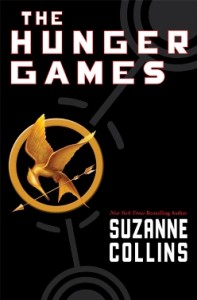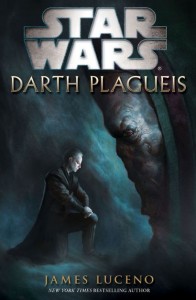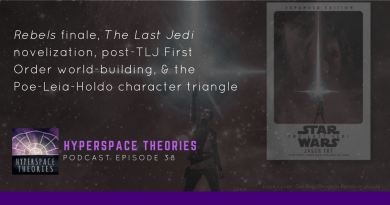Stories from a Certain Point of View
Cross-posted from Suvudu:
A young hero from a desolate and isolated region, torn from that life by the evil machinations of an oppressive regime, mentored by a wise-yet-weary warrior, forced into new alliances and a rebellion, a singular life-defining shot that hits its mark… I bet you thought I was talking about Star Wars.
 A movie came out yesterday called The Hunger Games – you might have heard of it. Despite the grim depiction of children forced to fight to the death, Suzanne Collins’ novel trilogy quickly picked up momentum at the Lomin Ale Cantina, where Star Wars Expanded Universe fans discuss our favorite franchise and all things storytelling-related. Considering that the Cantina members are specifically fond of Leia Organa Solo, Jaina Solo, Tahiri Veila, and Tenel Ka, among others, it’s not surprising we found Katniss Everdeen, and her heroine’s journey set against the backdrop of a brutal revolution, truly captivating. But its heroine is only part of the reason The Hunger Games is resonating with Star Wars fans. Earlier this week I discussed how the frenzy surrounding the upcoming theatrical release of The Hunger Games taps into some of the same cultural touchstones Star Wars did when it was released over three decades ago. While the two epic tales resonate clearly with a wide range of fans, it’s interesting to consider how their respective approaches to the hero’s or heroine’s journey came from two very different forms of storytelling and used completely different perspectives to engage their audiences.
A movie came out yesterday called The Hunger Games – you might have heard of it. Despite the grim depiction of children forced to fight to the death, Suzanne Collins’ novel trilogy quickly picked up momentum at the Lomin Ale Cantina, where Star Wars Expanded Universe fans discuss our favorite franchise and all things storytelling-related. Considering that the Cantina members are specifically fond of Leia Organa Solo, Jaina Solo, Tahiri Veila, and Tenel Ka, among others, it’s not surprising we found Katniss Everdeen, and her heroine’s journey set against the backdrop of a brutal revolution, truly captivating. But its heroine is only part of the reason The Hunger Games is resonating with Star Wars fans. Earlier this week I discussed how the frenzy surrounding the upcoming theatrical release of The Hunger Games taps into some of the same cultural touchstones Star Wars did when it was released over three decades ago. While the two epic tales resonate clearly with a wide range of fans, it’s interesting to consider how their respective approaches to the hero’s or heroine’s journey came from two very different forms of storytelling and used completely different perspectives to engage their audiences.
George Lucas is a storyteller who also happens to be a filmmaker, and the heroic rise of Luke Skywalker was envisioned as an epic adventure unlike anything moviegoers had ever seen. Star Wars, like most movies, is experienced from the point of view of an external observer. The audience watches events like the Death Star’s destruction unfold, but is not given the benefit of being omniscient or all-knowing; we are not allowed to see inside the characters’ heads. Lucas uses this point of view to his advantage as the saga unfolds. In Return of the Jedi, the tale of Luke’s father’s death at the hands of Darth Vader is justified by Obi-Wan Kenobi as being true from a “certain point of view;” in Revenge of the Sith, Chancellor Palpatine relates to Anakin Skywalker a version of the tragedy of Darth Plagueis that left fans pondering for years just how much truth there was in the Sith Lord’s recounting. The Star Wars movies use cinematic immersion on an epic scale, superimposing its heroes in a fight with overwhelming odds, to invest the audience in the outcome.
 In The Hunger Games novel, author Suzanne Collins reveals her dystopian society solely through the point of view of a single character. The oppressive grip of the Panem government is related to the reader through the eyes of Katniss. The reader experiences her hunger, her dysfunctional home life, her friendships and alliances, and ultimately her personal terror in the face of death. Unlike watching from afar, however, we see it all from inside Katniss’ head. Much of the world-building is left to the imagination as Katniss and her fellow tributes are whisked from their Districts and paraded around the Capitol before being thrust into a gladiator-style battle to the death. The insurmountable odds are revealed in intimate point of view revelations that highlight the heroine’s self-doubts about her weaknesses and underestimation of her advantages.
In The Hunger Games novel, author Suzanne Collins reveals her dystopian society solely through the point of view of a single character. The oppressive grip of the Panem government is related to the reader through the eyes of Katniss. The reader experiences her hunger, her dysfunctional home life, her friendships and alliances, and ultimately her personal terror in the face of death. Unlike watching from afar, however, we see it all from inside Katniss’ head. Much of the world-building is left to the imagination as Katniss and her fellow tributes are whisked from their Districts and paraded around the Capitol before being thrust into a gladiator-style battle to the death. The insurmountable odds are revealed in intimate point of view revelations that highlight the heroine’s self-doubts about her weaknesses and underestimation of her advantages.
The Hunger Games resonates much like Star Wars because both storytellers created their tales with a vision that included a detailed universe and a clear understanding of the characters’ motivations. It’s just that Lucas and Collins approached their story from different directions. The Hunger Games fans are eager to finally see the spectacle of the Capitol held up against the grim reality of the Districts. Gary Ross, the movie’s director, has said he wanted to maintain the intimate relationship of the audience with Katniss’ experience, and for that reason he chose to shoot much of the battle sequence with handheld cameras, and lead actress Jennifer Lawrence will be onscreen nearly the entire film. Yet some of the exposition that had to be conveyed with internal monologue in the novel can be brought to life on the big screen much simpler and faster by using scenes from outside her perspective, and several brand new scenes were written especially for the movie to do just that. As the tale of the rebellion unfolds in the upcoming movies, it’s likely the films will stray even more from Katniss’ exclusive perspective.
 Conversely, the ongoing success of the Star Wars franchise is owed in part to the breadth of its cast of characters, and the Expanded Universe has allowed fans to get inside numerous characters’ heads as we read their triumphs and struggles in the galaxy far, far away. Darth Plagueis is the most recent example of a novel peeling back the layers to reveal the motivations that drive Palpatine and his desire to eradicate the Jedi. Except for some brief lines of dialogue and the implications of the Empire’s tactics in the movies, until James Luceno took readers inside the Sith Lord’s head fans could only wonder what made him tick. Unlike The Hunger Games, which uses first-person point of view, Star Wars books almost exclusively have relied upon third-person limited point of view, a style that tells the story from one character’s perspective at a time but shifts among characters as the story requires. The exceptions are few but memorable: I, Jedi used first-person point of view to follow Rogue Squadron member Corran Horn as he trained as a Jedi, and the Revenge of the Sith novelization braved the rarely seen second-person narrative in a handful of scenes to help readers identify with Anakin Skywalker’s fall to the dark side.
Conversely, the ongoing success of the Star Wars franchise is owed in part to the breadth of its cast of characters, and the Expanded Universe has allowed fans to get inside numerous characters’ heads as we read their triumphs and struggles in the galaxy far, far away. Darth Plagueis is the most recent example of a novel peeling back the layers to reveal the motivations that drive Palpatine and his desire to eradicate the Jedi. Except for some brief lines of dialogue and the implications of the Empire’s tactics in the movies, until James Luceno took readers inside the Sith Lord’s head fans could only wonder what made him tick. Unlike The Hunger Games, which uses first-person point of view, Star Wars books almost exclusively have relied upon third-person limited point of view, a style that tells the story from one character’s perspective at a time but shifts among characters as the story requires. The exceptions are few but memorable: I, Jedi used first-person point of view to follow Rogue Squadron member Corran Horn as he trained as a Jedi, and the Revenge of the Sith novelization braved the rarely seen second-person narrative in a handful of scenes to help readers identify with Anakin Skywalker’s fall to the dark side.
There are advantages and disadvantages to each style of point of view. Controlling the reader’s or audience’s access to characters’ point of view can be used to hide other characters’ motivations, creating tension as the audience wonders what is really happening. In the Star Wars prequel trilogy, for example, Lucas kept the audience in the dark that Chancellor Palpatine was really Darth Sidious. On the other hand, using fewer points of view may take other storytelling techniques off the table, such as dramatic irony, in which tension is created when the reader knows something ominous the characters do not.
Collins did a masterful job using the first-person point of view in The Hunger Games trilogy to keep the reader wary of other characters’ allegiances. While the roles of President Snow, Haymitch Abernathy, and Cinna evolve in ways that are expected, other characters, particularly ones introduced in the second and third books such as Finnick Odair and President Coin, do not necessarily turn out to be who they appeared to be on first impression from Katniss’ perspective. In The Hunger Games movie, though, Collins – who co-wrote the film with Ross and screenwriter Billy Ray – took advantage of the broader point of view available in the movie to full effect. One of the new scenes, revealed last week as an official teaser, pulls back the curtain on Snow’s motivations in a way that cuts an even more chilling figure for the movie audience than was possible in the books from Katniss’ limited perspective.
As I read The Hunger Games trilogy, my appreciation for how well Collins used point of view to her advantage was owed specifically to what I have learned from Star Wars Expanded Universe authors over the many years I have been a fan. While I love the books because they can peek inside character’s heads, some of the most memorable Expanded Universe characters have been those whose motivations have been carefully avoided.  Grand Admiral Thrawn, a character introduced in Heir to the Empire, is highly intelligent, a cunning strategist, and driven to return the Empire to its position of power – but the reason behind why he does the things he does is always left open for debate. Thrawn can only be judged by his actions and deeds, not his internal perspective. Even two decades after his introduction, when Thrawn’s protégés show up in a book it’s hard to predict exactly what they’re going to do. Another example is Vergere, an alien Force-user who played a significant role in the New Jedi Order series. In the books Traitor and Destiny’s Way in particular her motivations and allegiance were simply inscrutable. She’s an ally; she’s a traitor. She’s lying; she’s telling the truth… Bringing up her name in a Star Wars Expanded Universe discussion can run the topic off into tangential and highly opinionated debates, which can vary from slightly amusing to mind-numbingly circular. The lack of any point of view from Vergere herself allowed the creative team for Legacy of the Force to take advantage of the mystery behind the character and use further unreliable narrators, who themselves might have been lying or telling the truth, to elaborate on Vergere’s supposed motivations and allegiances. Similarly, in the most recent series, Fate of the Jedi, the villainous Abeloth was portrayed, with only a bare handful of exceptions, from other characters’ points of view. Although she clearly was obsessed with Luke Skywalker and hated the Jedi, this use of point of view kept her ultimate goals for Luke and for the galaxy hidden from the readers until Apocalypse’s release this past week. And even then, the largest reveal of her background and motivations is gleaned from an unreliable narrator, and it is fun to wonder what holes in her backstory the Expanded Universe may use to its advantage in later books.
Grand Admiral Thrawn, a character introduced in Heir to the Empire, is highly intelligent, a cunning strategist, and driven to return the Empire to its position of power – but the reason behind why he does the things he does is always left open for debate. Thrawn can only be judged by his actions and deeds, not his internal perspective. Even two decades after his introduction, when Thrawn’s protégés show up in a book it’s hard to predict exactly what they’re going to do. Another example is Vergere, an alien Force-user who played a significant role in the New Jedi Order series. In the books Traitor and Destiny’s Way in particular her motivations and allegiance were simply inscrutable. She’s an ally; she’s a traitor. She’s lying; she’s telling the truth… Bringing up her name in a Star Wars Expanded Universe discussion can run the topic off into tangential and highly opinionated debates, which can vary from slightly amusing to mind-numbingly circular. The lack of any point of view from Vergere herself allowed the creative team for Legacy of the Force to take advantage of the mystery behind the character and use further unreliable narrators, who themselves might have been lying or telling the truth, to elaborate on Vergere’s supposed motivations and allegiances. Similarly, in the most recent series, Fate of the Jedi, the villainous Abeloth was portrayed, with only a bare handful of exceptions, from other characters’ points of view. Although she clearly was obsessed with Luke Skywalker and hated the Jedi, this use of point of view kept her ultimate goals for Luke and for the galaxy hidden from the readers until Apocalypse’s release this past week. And even then, the largest reveal of her background and motivations is gleaned from an unreliable narrator, and it is fun to wonder what holes in her backstory the Expanded Universe may use to its advantage in later books.
While enigmatic villains are interesting to dissect, I have to admit that a more intimate perspective from heroes as they brave their greatest challenges is what really draws me to books. Some of my favorite moments in Star Wars come in the novels, in overarching introspectives on what it means to be a Jedi – Mace Windu in Shatterpoint, Anakin Solo in Star by Star, and Jaina Solo in Invincible – but also in intensely personal moments such as Mara Jade Skywalker in Rebel Dream as she lets her son Ben go to the Maw so she can fight in the war, Leia Organa Solo in Tatooine Ghost wrestling with the ramifications of having Jedi children who would have the potential to sow destruction like their grandfather Darth Vader, or Jagged Fel in Fury showing a rare moment of weariness after scolding Jaina that she’s training away her humanity.
No matter the storytelling medium – books or movies – there is a common thread to creating resonance, whether it is Star Wars or The Hunger Games. Heroes and their personal struggles draw the audience in, while cleverly crafted villains and their elusive motivations define the stakes. The Hunger Games had all the key ingredients to captivate my imagination, but my time as a Star Wars fan and the things its storytellers have taught me undoubtedly have allowed me to appreciate the skill with which Katniss’ story has been told.
May the Odds Be Ever In Your Favor and the Force Be With You.
- Hyperspace Theories: SKELETON CREW Ahoy! - December 29, 2024
- Hyperspace Theories: WICKED Part I Rises to the Moment - December 6, 2024
- Columbia’s Vader™ Collection Launches Dec 5 - November 27, 2024









